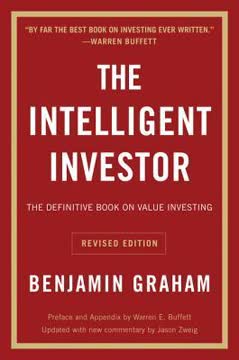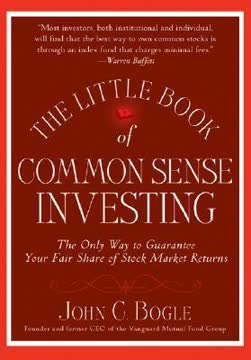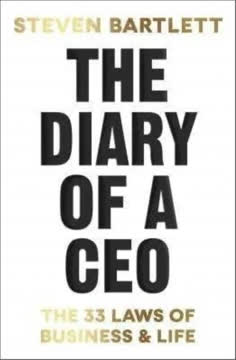Key Takeaways
1. Embrace Buffett's Two-Step Strategy: Wonderful Business, Wonderful Price
This book will provide you a 2-step framework to pick and choose stocks so that you will outperform your friends and Wall Street.
Simplicity wins. The core of successful stock market investing boils down to two essential steps: identifying a "wonderful business" and acquiring it at a "wonderful price." This framework, championed by Warren Buffett, cuts through the noise of complex financial jargon and focuses on the fundamentals of value investing. It's not about chasing fleeting trends or relying on gut feelings; it's about understanding the underlying business and its potential for long-term cash generation.
Quality over quantity. The strategy emphasizes selectivity. It's better to deeply understand a few exceptional businesses than to superficially analyze a multitude of companies. This concentrated approach allows investors to develop a strong conviction in their holdings, making them less susceptible to market fluctuations and emotional decision-making. The two-step framework is a filter, helping investors to focus on the opportunities that offer the greatest potential for outperformance.
Outperforming Wall Street. The goal isn't just to participate in the stock market; it's to beat it. By focusing on quality and value, investors can gain an edge over mutual fund managers and index funds, who are often constrained by diversification requirements and short-term performance pressures. This framework empowers individual investors to take control of their financial destiny and achieve superior returns.
2. Free Cash Flow: The Ultimate Investing Compass
You buy businesses for the cash that they will produce over their lifetime.
Cash is king. The ultimate principle of investing is to treat a stock as a fractional ownership in a real-life business. The value of that business lies in its ability to generate cash flow over its lifetime. Forget about P/E ratios and short-term price movements; focus on the underlying cash-generating engine.
Beyond net income. Net income, or earnings, can be misleading due to accounting practices like depreciation. Free cash flow (FCF), which represents the cash a business generates after accounting for capital expenditures, provides a more accurate picture of a company's financial health. FCF is the money available to owners, like rent from a real estate property after expenses.
Investing like Buffett. Warren Buffett emphasizes looking at the cash a business produces, not just its stock price. He compares buying a stock to buying an apartment building or a farm – you're investing in an asset that will generate income. This long-term, value-oriented approach is the key to building wealth in the stock market.
3. Moats: Protecting Your Investment Castle
Every business needs a strong moat because it makes it easier to compete against other businesses that want to steal the firm’s profits.
Defending profits. In the business world, a "moat" represents a company's competitive advantage – something that protects its profits from being eroded by competitors. Just as a moat protects a castle, a strong moat protects a business's long-term profitability. Without a moat, a company is vulnerable to competition and its profits are at risk.
Types of moats:
- Strong Brand: Customer trust and loyalty (e.g., Apple, Amazon)
- Designated Company: Essential service provider with limited competition (e.g., Waste Management)
- Intellectual Property: Patents, copyrights, trade secrets (e.g., Activision Blizzard)
Moat strength matters. It's not enough for a company to simply have a moat; it must be stronger than its competitors' moats. A weak moat is easily breached, leaving the company vulnerable. Focus on companies with durable, long-lasting moats that can withstand the test of time.
4. Predictability Over "The Next Big Thing"
Wonderful investment opportunities are not found in rapidly changing industries.
Slow and steady wins. Avoid the allure of "the next big thing" and focus on companies in slowly changing industries. Rapidly changing industries are inherently unpredictable, making it difficult to assess a company's long-term prospects. The technology sector, for example, is often characterized by rapid innovation and disruption, making it a risky place for long-term investors.
Predictability is key. The ability to predict a company's future cash flows is crucial for determining its intrinsic value. Companies in stable industries with strong moats are more likely to generate predictable cash flows, making them ideal investments. Think of companies like Starbucks, which can continue to offer their coffee for decades with little innovation.
Long-lasting moats. Warren Buffett seeks "long-lasting" moats. You want to invest in companies that will be dominant over the competition for many years to come. This requires avoiding industries where technology gets outdated quickly and focusing on businesses with durable competitive advantages.
5. Financial Health: The Bedrock of Wonderful Businesses
You always have to make sure that a company is financially healthy.
Numbers tell the story. At the end of the day, a company's financial health is reflected in its numbers. Analyzing financial statements – the income statement, balance sheet, and cash flow statement – is essential for determining whether a business is a good investment. Ideally, you want your business to be generating more cash 3 years from now than whatever amount it is generating today.
Key financial metrics:
- Profit Margin: Aim for at least 5% to ensure a sufficient cushion.
- Debt-to-Asset Ratio: Keep it under 0.35 to minimize risk.
- Long-Term Debt to Free Cash Flow Ratio: Stay below 3 to ensure debt repayment ability.
- Return on Invested Capital (ROIC): Look for a ROIC above 10% to indicate efficient capital allocation.
Free cash flow is key. The cash flow statement reveals how a business is receiving and spending money. Focus on free cash flow, which represents the excess cash a business produces after accounting for operating expenses and capital expenditures. A company with predictable and growing free cash flow is a sign of a financially healthy and wonderful business.
6. Intrinsic Value: Unlocking the Wonderful Price
Intrinsic value can be defined simply: it is the discounted value of the cash that can be taken out of a business during its remaining life.
The ideal price. The intrinsic value of a stock is the ideal price to purchase it in order to get a good return on investment. It's the price that reflects the present value of all the future cash flows a business is expected to generate. This requires estimating future free cash flows and discounting them back to their present value.
Time value of money. Money has a "time value" – it's more valuable today than it is in the future because it has the potential to compound and grow. Therefore, future cash flows must be discounted to reflect their present value. The further into the future a cash flow is expected to be received, the lower its present value.
Calculating intrinsic value. The formula for calculating intrinsic value involves estimating future free cash flows, determining a required rate of return (typically 10%), and applying a perpetual growth rate. This calculation provides a framework for determining a fair price to pay for a stock, ensuring a good return on investment.
7. Dividends: Powering Passive Income the Right Way
In this chapter, we will go over how to use discounted cash flow analysis to calculate the intrinsic value of a dividend stock.
Beyond yield. Dividend investing can be a viable strategy for generating passive income, but it's crucial to go beyond simply looking at dividend yield. Many investors make the mistake of buying dividend stocks solely based on their yield, payout ratio, and dividend history, without conducting a thorough analysis of the underlying business.
Intrinsic value of dividends. The key to successful dividend investing is to calculate the intrinsic value of the dividends a stock is expected to pay. This involves forecasting future dividend payments and discounting them back to their present value, similar to calculating the intrinsic value of free cash flow.
Key dividend metrics:
- Payout Ratio: Keep it below 70% to ensure dividend sustainability and growth potential.
- Earnings Growth: Look for companies with expected earnings growth of at least 4% per year.
- Required Rate of Return: Use a required rate of return of 6% when discounting dividend payments.
8. Diversification: A Double-Edged Sword
Diversification, as practiced generally, makes very little sense for anyone that knows what they are doing.
Risk mitigation. Diversification, the process of spreading your risk across multiple investments, is often praised for its ability to protect your hard-earned money. By owning a variety of stocks, you can mitigate the impact of any single investment going sour. However, diversification can also come at a cost.
Opportunity cost. Every time you add a new stock to your portfolio, you're potentially allocating less money to a better stock. Over-diversification can lead to owning too many mediocre companies, diluting your returns and making it difficult to outperform the market. As Warren Buffett says, "Diversification is a protection against ignorance."
Finding the balance. The ideal number of stocks to own depends on your comfort level and investing knowledge. A portfolio of 5-15 different companies can strike a good balance between diversification and concentration in strong companies. Avoid having a single company represent more than 20% of your portfolio.
9. Emotions: The Silent Portfolio Killer
The most important quality for an investor is temperament, not intellect.
Rationality is key. Your emotions are your greatest enemy when investing in stocks. Fear, greed, and other emotions can cloud your judgment and lead to irrational decisions. It's crucial to understand how your emotions can sabotage your investment strategy and develop strategies to mitigate their impact.
Common emotional traps:
- Anchor Pricing: Thinking a stock is cheap simply because its price has fallen.
- Monte Carlo Fallacy: Believing that past events predict future stock prices.
- Keeping Up with the Joneses: Buying a stock simply because someone else has.
Reduce emotional decision-making. One of the best ways to combat emotional investing is to simply pay less attention to the markets. Avoid constantly checking your portfolio, as this can trigger anxiety and lead to impulsive decisions. Focus on the long-term potential of your investments and resist the urge to sell during market downturns.
10. Market Cap: Size Doesn't Always Matter
Buy a stock the way you would buy a house. Understand it and like it such that you’d be content to own it in the absence of a market.
Beyond classifications. Market capitalization, which refers to the total value of a company's outstanding shares, is often used to categorize stocks as micro-cap, small-cap, mid-cap, large-cap, or mega-cap. While market cap can provide some insights, it's important not to rely solely on this metric when making investment decisions.
Opportunities across the spectrum. Both large-cap and small-cap stocks have their advantages. Large-cap stocks tend to be more stable and well-known, while small-cap stocks may offer greater growth potential. However, the key is to focus on finding wonderful businesses at wonderful prices, regardless of their market capitalization.
Focus on fundamentals. At the end of the day, market capitalization doesn't matter. What matters is the quality of the business and the price you pay for it. A wonderful business at a wonderful price is a good investment, regardless of its size.
Last updated:
Review Summary
Buffett's 2-Step Stock Market Strategy receives mixed reviews, with an overall rating of 4.02 out of 5. Many readers find it clear, concise, and easy to understand, praising its explanation of fundamental investing concepts. Some consider it an excellent guide for beginners or intermediate investors, while others find it simplistic. The book is commended for its research and practical approach to long-term investing. However, a few critics argue that the information is basic or repetitive. Despite some disagreements, most reviewers appreciate the book's straightforward explanation of Buffett's investment strategies.
Similar Books










Download PDF
Download EPUB
.epub digital book format is ideal for reading ebooks on phones, tablets, and e-readers.




